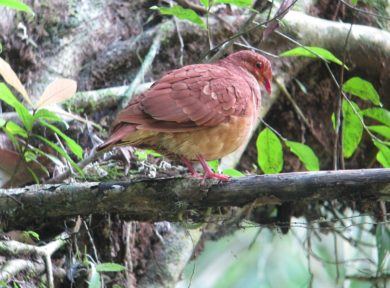In September of 2017, hurricanes Irma and Maria delivered a devastating one-two punch to Puerto Rico, causing massive defoliation of the island’s forests. While the detrimental effects of these storms on human populations were well-documented, little was known about impacts on the island’s bird populations—until now. A new paper published in PLOS ONE by VCE and colleagues compares occupancy of birds in forested areas across Puerto Rico during a winter before (2015) and shortly after (2018) the passage of these hurricanes. Using field surveys and population modeling, our researchers discovered significant changes in species detection, with some species becoming more readily detected after the storms while others became more difficult to detect.
In 2015, Chris Rimmer and John Lloyd (now of American Wind Wildlife Institute), along with José Salguero-Faría of Sociedad Ornitológica Puertorriqueña, conducted geographically extensive surveys across Puerto Rico to study the winter distribution of Bicknell’s Thrush. Although focused on locating Bicknell’s, the team recorded all avian species detected during 211 point count surveys, for general insight into the assemblage of forest birds present on Puerto Rico during winter. As serendipity would have it, their cross-species data proved invaluable to assess the impacts of catastrophic weather on the island’s birds.
”You can’t plan a study of a hurricane,” stated John Lloyd, lead author on the paper. “We happened to have counted birds across the island in 2015 as part of an unrelated project, and when the scope of the damage caused by Irma and Maria became clear, we realized that we needed to return to our study sites and see what had changed.”
With support from the National Fish and Wildlife Foundation, the U.S. Fish and Wildlife Service, the USDA Forest Service Office of International Programs, and the Farallon Islands Foundation, the team returned to Puerto Rico in 2018 and was able to resurvey 186 points from the 2015 survey. They found that roughly 50% of the 35 species analyzed showed significant changes in occupancy between pre- and post-hurricane surveys. Furthermore, far more species appeared to have declined as a result of hurricanes Irma and Maria than to have increased, and the magnitude of the change in occupancy was greater for decreasing species than it was for increasing species.

Ruddy Quail-Dove / © Félix Uribe (CC BY-SA 2.0)
Lloyd noted, “The most obvious difference was that fruit-dependent birds had become incredibly scarce, probably because wind and heavy rain stripped most of the trees of their fruits and flowers. Scaly-naped Pigeon, for example, was common across our sites in 2015, but we found it in only a handful of places after the hurricanes. We saw the same thing with Ruddy Quail-Dove and Antillean Euphonia. The good news, though, is that these birds—and the island’s forests—are pretty resilient to the effects of hurricanes. We’ve seen in studies of previous hurricanes, like Hugo and Gilbert, that bird populations may crash immediately after a storm, but, as the forests recover, populations of most species eventually rebound.”
These results add to the body of empirical findings regarding the effects of hurricanes on birds, and support the general conclusion that impacts are species-specific—how different species fare after a storm depends on how the forest structure changes. For an in-depth look at these results and study methodologies (in truly excruciating detail), head over to PLOS ONE to read their paper. With current climate change models predicting that hurricanes will increase in intensity and duration, more studies of this kind will be critical to understand the wider implications of violent storms on avian ecology writ large.


